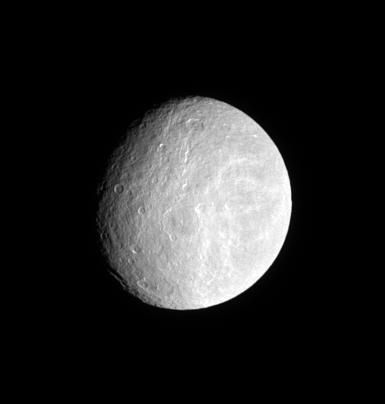Ancient Plains of Rhea

| PIA Number | PIA09895 |
|---|---|
| Language |
|
Densely cratered plains cover the ancient surface of Saturn's moon Rhea.
Following the Voyager spacecraft encounters with Saturn, cryovolcanism was suggested as a source for the wispy markings on both Rhea and Dione. Cassini has shown that Rhea's bright streaks are, like those on Dione, tectonic features. Planetary scientists now think it is unlikely that cryovolcanic activity has ever occurred on this moon.
This view looks toward the trailing hemisphere of Rhea (1,528 kilometers, or 949 miles across). North is up.
The image was taken in visible light with the Cassini spacecraft narrow-angle camera on April 4, 2008. The view was acquired at a distance of approximately 1.2 million kilometers (735,000 miles) from Rhea and at a Sun-Rhea-spacecraft, or phase, angle of 39 degrees. Image scale is 7 kilometers (4 miles) per pixel.
The Cassini-Huygens mission is a cooperative project of NASA, the European Space Agency and the Italian Space Agency. The Jet Propulsion Laboratory, a division of the California Institute of Technology in Pasadena, manages the mission for NASA's Science Mission Directorate, Washington, D.C. The Cassini orbiter and its two onboard cameras were designed, developed and assembled at JPL. The imaging operations center is based at the Space Science Institute in Boulder, Colo.
For more information about the Cassini-Huygens mission visit http://saturn.jpl.nasa.gov . The Cassini imaging team homepage is at http://ciclops.org .
Credit: NASA/JPL/Space Science Institute
